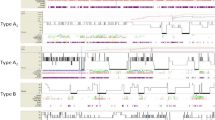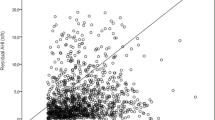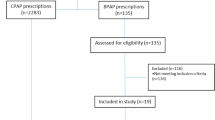Abstract
Objective
To evaluate the performance of clinical criteria (CC) for diagnosis and initiation of empirical treatment with continuous positive airway pressure (CPAP) in patients with suspected obstructive sleep apnea (OSA) compared with the treatment decision based on sleep studies (polysomnography or respiratory polygraphy), guidelines, and experience of participating physicians.
Methods
This was a simulated intention-to-treat study in a retrospective (G1) and prospective (G2) cohort. Four observers (two per group) called CC1 and CC2 reviewed the sleep questionnaires and indicated CPAP if the patients presented snoring, frequent apneas (≥ 3–4/week), body mass index (BMI) > 25 kg/m2, sleepiness (Epworth > 11), or tiredness (at least 3–4 times per week) and some comorbidity (hypertension, coronary/cerebrovascular event, diabetes). Ten independent observers formed two groups of five (FD1 and FD2) and were blinded to each other’s opinion. These observers in FD1 and FD2 decided CPAP treatment based on guidelines of the Spanish Society of Pulmonology and Thoracic Surgery (SEPAR) or guidelines of the American Academy of Sleep Medicine (AASM) and factored in their own opinion. Sensitivity (S), specificity (Sp), and positive/negative likelihood ratios (LR+/−) were calculated with the test method: CC1/2, and the reference method: majority decision of FD1/2.
Results
A total of 653 patients (264 women, 40%) were studied. Median age was 54 years, BMI 28 kg/m2, and apnea hypopnea index (AHI) 16.5 events/h. S ranged from 21 to 25% (p 0.60), Sp 96.1 to 97.6% (p 0.39), and LR+ of clinical criteria 6.4 to 8.9 (p 0.52).
Conclusion
CPAP indication without a previous sleep study showed a low sensitivity (≅ 22%) but a specificity greater than 95% in patients with high pretest probability for OSA (snoring, report of frequent apneas, BMI > 25 kg/m2 and sleepiness or tiredness plus comorbidity).


Similar content being viewed by others
References
Franklin KA, Lindberg E (2015) Obstructive sleep apnea is a common disorder in the population-a review on the epidemiology of sleep apnea. J Thorac Dis 7(8):1311–1322
Kendzerska T, Mollayeva T, Gershon AS, Leung RS, Hawker G, Tomlinson G (2014) Untreated obstructive sleep apnea and the risk for serious long-term adverse outcomes: a systematic review. Sleep Med Rev 18(1):49–59
Teran-Santos J, Jimenez-Gomez A, Cordero-Guevara J (1999) The association between sleep apnea and the risk of traffic accidents. Cooperative Group Burgos-Santander. N Engl J Med 340(11):847–851
Bjornsdottir E, Keenan BT, Eysteinsdottir B, Arnardottir ES, Janson C, Gislason T, Sigurdsson JF, Kuna ST, Pack AI, Benediktsdottir B (2015) Quality of life among untreated sleep apnea patients compared with the general population and changes after treatment with positive airway pressure. J Sleep Res 24(3):328–838
Jenkinson C, Davies RJ, Mullins R, Stradling JR (1999) Comparison of therapeutic and sub-therapeutic nasal continuous positive airway pressure for obstructive sleep apnoea: a randomised prospective parallel trial. Lancet 353(9170):2100–2105
Batool-Anwar S, Goodwin JL, Kushida CA, Walsh JA, Simon RD, Nichols DA, Quan SF (2016) Impact of continuous positive airway pressure (CPAP) on quality of life in patients with obstructive sleep apnea (OSA). Sleep Res 25(6):731–738
Karimi M, Hedner J, Häbel H, Nerman O, Grote L (2015) Sleep apnea-related risk of motor vehicle accidents is reduced by continuous positive airway pressure: Swedish Traffic Accident Registry data. Sleep 38(3):341–349
Fava C, Dorigoni S, Dalle Vedove F, Danese E, Montagnana M, Guidi GC, Narkiewicz K, Minuz P (2014) Effect of CPAP on blood pressure in patients with OSA/hypopnea a systematic review and meta-analysis. Chest 145(4):762–771
Kuhn E, Schwarz EI, Bratton DJ, Rossi VA, Kohler M (2017) Effects of CPAP and mandibular advancement devices on health-related quality of life in OSA: a systematic review and meta-analysis. Chest 151(4):786–794
Kapur VK, Auckley DH, Chowdhuri S, Kuhlmann DC, Mehra R, Ramar K, Harrod CG (2017) Clinical practice guideline for diagnostic testing for adult obstructive sleep apnea: an American Academy of Sleep Medicine Clinical Practice Guideline. J Clin Sleep Med 13(3):479–504
Young T, Evans L, Finn L, Palta M (1997) Estimation of the clinically diagnosed proportion of sleep apnea syndrome in middle aged men and women. Sleep 20(9):705–706
Flemons WW, Douglas NJ, Kuna ST, Rodenstein DO, Wheatley J (2004) Access to diagnosis and treatment of patients with suspected sleep apnea. Am J Respir Crit Care Med 169(6):668–672
Knauert M, Naik S, Gillespie MB, Kryger M (2015) Clinical consequences and economic costs of untreated obstructive sleep apnea syndrome. World J Otorhinolaryngol Head Neck Surg 1(1):17–27
Nigro CA, Dibur E, Aragone MR, Borsini E, Ernst G, Nogueria F (2016) Can CPAP be indicated in adult patients with suspected obstructive sleep apnea only on the basis of clinical data? Sleep Breath 20(1):175–182
Borsini EE, Blanco M, Ernst G, Montenegro P, Salvado A, Nigro C (2018) Simulated intention-to-treat analysis based on clinical parameters of patients at high risk for sleep apnea derivated to respiratory polygraphy. Sleep Sci 11(3):160–165
Lloberes P, Durán-Cantolla J, Martínez-García MÁ, Marín JM, Ferrer A, Corral J, Masa JF, Parra O, Alonso-Álvarez ML, Terán-Santos J (2011) Diagnosis and treatment of sleep apnea-hypopnea syndrome. Spanish Society of Pulmonology and Thoracic Surgery. Arch Bronconeumol 47(3):143–156
Kushida CA, Littner MR, Hirshkowitz M, Morgenthaler TI, Alessi CA, Bailey D, Boehlecke B, Brown TM, Coleman J Jr, Friedman L, Kapen S, Kapur VK, Kramer M, Lee-Chiong T, Owens J, Pancer JP, Swick TJ, Wise MS (2006) American Academy of Sleep Medicine. Practice parameters for the use of continuous and bilevel positive airway pressure devices to treat adult patients with sleep related breathing disorders. Sleep 29(3):375–380
Borsini E, Maldonado L, Décima T, Bosio M, Quadrelli S, Chertcoff J, Salvado A (2013) Estrategia de utilización domiciliaria de la poligrafía respiratoria con instalación por el propio paciente. Rev Arg Med Resp 13(1):4–11
Berry RB, Budhiraja R, Gottlieb DJ, Gozal D, Iber C, Kapur VK, Marcus CL, Mehra R, Parthasarathy S, Quan SF, Redline S, Strohl KP, Ward SLD, Tangredi MM (2012) Rules for scoring respiratory events in sleep: update of the 2007 AASM Manual for the Scoring of Sleep and Associated Events. J Clin Sleep Med 8(5):597–619
Le Bon O, Hoffmann G, Tecco J, Staner L, Noseda A, Pelc I, Linkowski P (2000) Mild to moderate sleep respiratory events: one negative night may not be enough. Chest 118(2):353–359
Fagan TJ (1975) Nomogram for Bayes theorem. N Engl J Med 293(5):257
Senn O, Brack T, Russi EW, Bloch KE (2006) A continuous positive airway pressure trial as a novel approach to the diagnosis of the obstructive sleep apnea syndrome. Chest 129(1):67–75
Skomro RP, Cotton DJ, Gjevre JA, Grover VK, McNab BD, Reid JK, Ward HA (2007) An empirical continuous positive airway pressure trial for suspected obstructive sleep apnea. Can Respir J 14(3):159–163
Acknowledgments
The authors wish to thank Mrs. María Dolores Marinaro, Matías Castilla and polysomnography technicians Sergio González, Marcelo González, and Anabella Arce for their assistance in collecting data.
Author information
Authors and Affiliations
Contributions
Study design: CAN, EB; data collection: MB, EB, ED, CB, SM, SG, IB; statistical analysis: CAN, GE; data interpretation: CAN, FN, EB, ED; manuscript preparation: CAN, FN, EB, LL, AC, CE, MV, CB; literature search: ED, MV, SM.
Ethics declarations
Conflict of Interest
The authors declare that they have no conflict of interest.
Ethical approval
All procedures performed in studies involving human participants were in accordance with the ethical standards of our institutional committee and with the 1964 Helsinki declaration and its later amendments.
Additional information
Publisher’s note
Springer Nature remains neutral with regard to jurisdictional claims in published maps and institutional affiliations.
Rights and permissions
About this article
Cite this article
Nigro, C.A., Borsini, E., Dibur, E. et al. Indication of CPAP without a sleep study in patients with high pretest probability of obstructive sleep apnea. Sleep Breath 24, 1043–1050 (2020). https://doi.org/10.1007/s11325-019-01949-6
Received:
Revised:
Accepted:
Published:
Issue Date:
DOI: https://doi.org/10.1007/s11325-019-01949-6




